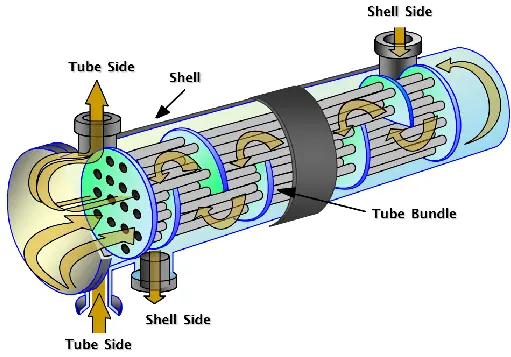Tube Side and Shell Side in a Shell-and-Tube Heat Exchanger
On this page
The shell-and-tube heat exchanger is one of the most common heat exchange devices in industrial production. Known for its efficiency and stability, it is widely used in industries like chemical processing, petroleum, and energy. It operates by facilitating heat transfer between fluids through two main components: the tube side and the shell side. The design of these two sections and the paths chosen for the fluids directly impact the exchanger's performance and heat transfer efficiency. Understanding the roles and differences between the tube side and the shell side is crucial for optimizing the design of shell-and-tube heat exchangers and enhancing industrial heat exchange efficiency. This article explores the functions, heat transfer mechanisms, and importance of the tube side and shell side in overall exchanger performance.

Function and Design of the Tube Side
The tube side refers to the fluid passage within the bundle of tubes inside the heat exchanger. The tube bundle typically consists of several metal tubes, and as the fluid flows through the tubes, it comes into contact with the tube walls, transferring heat via conduction or convection. The primary function of the tube side is to provide a flow path for high-temperature or high-pressure fluids, usually using materials like stainless steel or copper alloys, which have excellent thermal conductivity.
Design Features
Single-Pass vs. Multi-Pass Structure: Depending on the process needs, the tube side can be designed as a single-pass or multi-pass structure. A multi-pass design is often used to improve heat transfer efficiency by increasing the complexity of the fluid path.
Finned and Helical Tubes: To enhance heat transfer efficiency by increasing surface area, special designs like finned tubes or helical tubes are often used. These designs increase the contact area between the fluid and the tube walls, significantly boosting the rate of heat transfer.
Fluid Selection: The fluid in the tube side is typically higher pressure or prone to scaling since the tubes are easier to clean and maintain. Additionally, the tube walls are designed to withstand higher pressure levels.
Function and Design of the Shell Side
The shell side refers to the external fluid passage surrounding the tube bundle, formed by the heat exchanger's shell and other structural components like tube sheets. Its main role is to provide a flow path for the external fluid, allowing heat transfer between the fluid inside the tubes and the fluid outside. The shell side also offers structural support and protection to ensure the tube bundle operates stably.
Design Features
Fluid Guidance and Heat Transfer Support: The shell side fluid is guided through the space around the tubes, allowing heat exchange with the tube side fluid via the tube walls. The design of the shell side has a direct impact on the efficiency of heat transfer.
Pressure and Temperature Balance: The shell side usually handles lower pressure, making it suitable for fluids with relatively stable flow and larger temperature differences, such as steam. The fluid path layout and flow rate in the shell side are critical to heat exchange efficiency.
Structural Support: The shell not only acts as a barrier for the tube side but also supports the tube bundle and provides necessary mechanical strength. The shell side design must consider the mechanical strength needed for long-term operation under high temperature or pressure conditions.
Heat Transfer Mechanism Between Tube Side and Shell Side
In a shell-and-tube heat exchanger, heat is transferred between the tube side and shell side fluids through the tube walls. The heat exchange process typically involves the following mechanisms.
Convection Heat Transfer: Heat is transferred as the fluids flow along the inner and outer surfaces of the tubes. Both the tube side and shell side fluids exchange heat through contact with the tube walls.
Conduction: Heat moves through the tube wall material from the hot fluid to the cooler fluid. Materials with good thermal conductivity, such as stainless steel or copper, greatly enhance the efficiency of heat exchange.
Radiation Heat Transfer: Although radiation plays a minor role in shell-and-tube heat exchangers, it can affect heat transfer efficiency in extremely high-temperature environments.
Fluid Selection Principles for Tube Side and Shell Side
To optimize the heat transfer performance of a shell-and-tube heat exchanger, fluid selection for the tube side and shell side should follow these principles.
Fluids that are dirty or prone to scaling should flow through the tube side because cleaning and maintenance of the tubes are easier.
Corrosive fluids should flow through the tube side to avoid corroding the entire shell and to minimize the risk of damaging the equipment.
High-pressure fluids should be routed through the tube side since the tube bundle is designed to withstand higher pressures, while the shell is generally not suited for high-pressure environments.
Saturated steam is typically directed through the shell side because the heat transfer coefficient of steam condensation is independent of flow velocity, and condensate can be easily drained.
For fluids with large temperature differences, in fixed tube sheet heat exchangers, fluids with a high heat transfer coefficient are better suited for the shell side to reduce thermal stress and extend the equipment's lifespan.
Conclusion
The tube side and shell side are essential components of a shell-and-tube heat exchanger, each playing distinct roles in the heat transfer process. By designing the tube bundle and shell structure appropriately and selecting the right fluid paths and materials, shell-and-tube heat exchangers can achieve efficient heat exchange under various conditions. As industrial demands continue to grow, future advancements in shell-and-tube heat exchangers will focus on innovations in design, materials, and processes to further improve heat exchange efficiency and equipment longevity, contributing to greater energy savings and efficiency in various industries.

